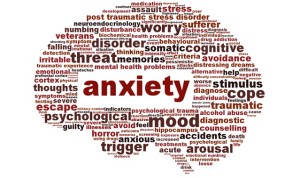 John* gets triggered easily and quickly. By having this interview, his breathing becomes heavier, faster.
John* gets triggered easily and quickly. By having this interview, his breathing becomes heavier, faster.
His heart starts beating rapidly. His stomach now hurts. His thoughts go crazy. Adrenaline starts to rush.
He immediately begins repetitive patterns of behavior to soothe himself. He rubs his fingertips. He pops his knuckles in sequence. He pulls on the hair on the right side of his head. He thinks of getting on his skateboard or finding a quiet area to be alone.
When asked how often he feels this anxiety, he stated “at least once a day.” His youngest memory of anxiety is when he was 8 years old. He describes what his thoughts started to do to him in this moment and what they continue to do to him since.
“I can’t think very straight. I think I am going to die or beat something up. Sometimes I even get angry. When it’s really bad I get a huge migraine.”
What else triggers John? Stairwells. A person who is repetitive. Trying new things. Loud noises. Crowds (more than 6-7 people). Walking down the halls at school. Being called on at school. Uncomfortable clothes. Observing others arguing. Certain textures of foods. Messes. Weather. Family gatherings. Being the center of attention. Pictures of himself. Music concerts. Elevators or other small spaces.
John is 14 years old. He is an incredible teenager. He is kind hearted. He works hard. He makes logical connections easily. He is book smart. He is funny. He has a smile that can light up a room. He thinks deeply. Yet he gets hijacked easily.
 His rational brain gets hijacked by his “flight or fight” response, which is designed to protect him in extreme situations (think bank robbery) yet is being triggered by small, seemingly insignificant events. When his flight or fight response kicks in, he is unable to think clearly, to feel rationally or to act normally….
His rational brain gets hijacked by his “flight or fight” response, which is designed to protect him in extreme situations (think bank robbery) yet is being triggered by small, seemingly insignificant events. When his flight or fight response kicks in, he is unable to think clearly, to feel rationally or to act normally….
….this can last for hours. It is exhausting! All of us have anxiety from time to time. But when our rational brain is routinely taken over by anxiety on a daily basis, it changes our patterns of thought.
During his interview, John asked an incredible question- “Why can’t I get used to it?” If it happens to him every single day, why has he not adapted and adjusted to the panic?
The answer is simple. John’s brain is now hardwired so that a trigger automatically gets an anxious reaction. It’s as instant as salt & __________ (did you think “pepper”?) or green light means _________ (did you think “go”?) His brain now says “you are in a stairwell, get anxious.” Or “there’s a family party tonight, time to freak out.” He does not even have to do anything. His brain is doing it all automatically. So what on earth can he do about it??
In their book, Neural Path Therapy, Matthew McKay and David Harp describe the way that you can change the automatic pairing of trigger & reaction that your brain does. They call it “R & R” or “Relax & Release.”
 They state “the single best way to stimulate the relax and release response and short circuit the fight or flight response, is to focus your mental attention onto your own breath.”
They state “the single best way to stimulate the relax and release response and short circuit the fight or flight response, is to focus your mental attention onto your own breath.”
To turn your attention from the scary thing that is in front of your face (like walking down the hall at school) to your own breathing allows you to use and strengthen a different part of your brain, a part that allows you to regain control of your feelings.
The authors suggest that you practice with a mild trigger and repractice…and repractice…and repractice. Notice your breathing pattern and alter it by a variety of relaxation techniques—deep breathing, visualizing a calm and peaceful place, counting breaths, etc. Once you are able to anticipate your mild trigger and manage your breathing, effectively cutting off the fight or flight response, move to a higher level trigger.
As with all things, practice is key. It is natural to slip up, revert back to previous ways of panic and forget to relax your brain. You are fighting a brain that has been well trained. Keep trying. Keep changing that response. Over time, your brain will create a new pathway and will start to automatically pair a positive or neutral feeling with your trigger.
Practical application:
What is the most effective strategy for John as he tries to handle his fight or flight triggering? You guessed it. He controls his breathing by “breathing slower.” The more he practices, the more successful he will be at kicking the symptoms of anxiety to the curb. Are you feeling super anxious way too often? Notice your breathing and change it. It will get you on track to make some positive changes!
If you liked this post and found it valuable, please leave a comment below and share it with your friends.
Take Care,
Kristel Scoresby

P.S. Be sure to pick up your copy of “Neural Path Therapy: How to Change Your Brain’s Response to Anger, Fear, Pain, and Desire” by Matthew McKay and David Harp. This can be used for multiple applications – not just anxiety.
Be sure to share this post on “[Interview] Exclusive Look Into Teenage Anxiety” with your friends.
*Name has been changed to protect identity.

